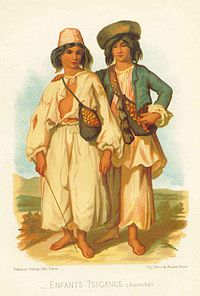The Romani people in Austria (German: Roma in Österreich) have lived in the country since the Middle Ages.[1] According to the 2001 census, there were 6,273 Romani speakers in Austria, or less than 0.1% of the population. Estimations count between 10,000 and 25,000.[2] A more recent estimation count between 40,000 and 50,000 Romani people or about 0.5%.[3] Most indigenous Romani people in Austria belong to the Burgenland-Roma group in East-Austria. The majority live in the state of Burgenland, in the city of Oberwart and in villages next to the District of Oberwart. The Burgenland-Roma speak the Vlax Romani language.
 Chromolithograph of young Roma in Austria | |
| Total population | |
|---|---|
| |
| Languages | |
| Romani, Sintitikes, German | |
| Religion | |
| Christianity, Romani folklore | |
| Related ethnic groups | |
| Romani people in Germany, Romani people in Hungary, Romani people in Slovenia, Romani people in Switzerland |
In Upper Austria there are also some Sinti families with 80% of the Sinti speaking the Sinte Romani dialect of the Romani language.
Since 1960, there has also been a significant Roma population originally from former Yugoslavian countries, especially from Serbia (Gurbeti and Kalderash Roma-Groups) and Ashkali from Kosovo and also some from Turkey.
History
editOrigin
editThe Romani people originate from Northern India,[4][5][6][7][8][9] presumably from the states of Rajasthan[8][9] and Punjab.[8]
The linguistic evidence has indisputably shown that roots of Romani language lie in India: the language has grammatical characteristics of Indian languages and shares a big part of the basic lexicon, for example, body parts or daily routines.[10]
More exactly, Romani shares the basic lexicon with Hindi and Punjabi. It shares many phonetic features with Marwari, while its grammar is closest to Bengali.[11]
Genetic findings in 2012 suggest the Romani migrated as a group.[5][6][12] According to a genetic study in 2012, the ancestors of present scheduled tribes and scheduled caste populations of Northern India, traditionally referred to collectively as the Ḍoma, are the likely ancestral populations of modern European Roma.[13]
In February 2016, during the International Roma Conference, the Indian Minister of External Affairs stated that the people of the Roma community were children of India. The conference ended with a recommendation to the Government of India to recognize the Roma community spread across 30 countries as a part of the Indian diaspora.[14]
Romani history in Austria
editIn the Habsburg monarchy under Maria Theresa (1740–1780), a series of decrees tried to force the Romanies to permanently settle, removed rights to horse and wagon ownership (1754), renamed them as "New Citizens" and forced Romani boys into military service if they had no trade (1761), forced them to register with the local authorities (1767), and prohibited marriage between Romanies (1773). Her successor Josef II prohibited the wearing of traditional Romani clothing and the use of the Romani language, punishable by flogging.[15]
See also
editReferences
edit- ^ "Performance in Gypsy Autobiographies from Austria and Germany". Dickinson College. Retrieved 2012-08-26.
- ^ "World Directory of Minorities and Indigenous Peoples - Austria : Roma/Gypsies". United Nations Human Rights Council. Retrieved 2012-08-26.
- ^ "Etwa 40.000 Roma und Sinti leben in Österreich | Medien Servicestelle Neue ÖsterreicherInnen" (in German). Archived from the original on 2016-03-04. Retrieved 2019-05-15.
- ^ Hancock, Ian F. (2005) [2002]. We are the Romani People. Univ of Hertfordshire Press. p. 70. ISBN 978-1-902806-19-8: ‘While a nine century removal from India has diluted Indian biological connection to the extent that for some Romani groups, it may be hardly representative today, Sarren (1976:72) concluded that we still remain together, genetically, Asian rather than European’
{{cite book}}: CS1 maint: postscript (link) - ^ a b Mendizabal, Isabel (6 December 2012). "Reconstructing the Population History of European Romani from Genome-wide Data". Current Biology. 22 (24): 2342–2349. doi:10.1016/j.cub.2012.10.039. hdl:10230/25348. PMID 23219723.
- ^ a b Sindya N. Bhanoo (11 December 2012). "Genomic Study Traces Roma to Northern India". The New York Times.
- ^ Current Biology.
- ^ a b c K. Meira Goldberg; Ninotchka Devorah Bennahum; Michelle Heffner Hayes (2015-09-28). Flamenco on the Global Stage: Historical, Critical and Theoretical Perspectives. p. 50. ISBN 9780786494705. Retrieved 2016-05-21.
- ^ a b Simon Broughton; Mark Ellingham; Richard Trillo (1999). World Music: Africa, Europe and the Middle East. Rough Guides. p. 147. ISBN 9781858286358. Retrieved 2016-05-21.
Roma Rajastan Penjab.
- ^ Šebková, Hana; Žlnayová, Edita (1998), Nástin mluvnice slovenské romštiny (pro pedagogické účely) (PDF), Ústí nad Labem: Pedagogická fakulta Univerzity J. E. Purkyně v Ústí nad Labem, p. 4, ISBN 80-7044-205-0, archived from the original (PDF) on 2016-03-04
- ^ Hübschmannová, Milena (1995). "Romaňi čhib – romština: Několik základních informací o romském jazyku". Bulletin Muzea Romské Kultury (4/1995). Brno: Muzeum romské kultury.
Zatímco romská lexika je bližší hindštině, marvárštině, pandžábštině atd., v gramatické sféře nacházíme mnoho shod s východoindickým jazykem, s bengálštinou.
- ^ "5 Intriguing Facts About the Roma". Live Science.
- ^ Rai, N; Chaubey, G; Tamang, R; Pathak, AK; Singh, VK (2012), "The Phylogeography of Y-Chromosome Haplogroup H1a1a-M82 Reveals the Likely Indian Origin of the European Romani Populations", PLOS ONE, 7 (11): e48477, Bibcode:2012PLoSO...748477R, doi:10.1371/journal.pone.0048477, PMC 3509117, PMID 23209554
- ^ "Can Romas be part of Indian diaspora?". khaleejtimes.com. 29 February 2016. Retrieved 4 March 2016.
- ^ Samer, Helmut (December 2001). "Maria Theresia and Joseph II: Policies of Assimilation in the Age of Enlightened Absolutism". Rombase. Karl-Franzens-Universitaet Graz.